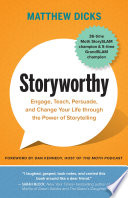

Storytelling is an essential tool for communication that transcends mere information sharing. It engages audiences on an emotional level, making messages more memorable and impactful. In 'Storyworthy', Matthew Dicks emphasizes that everyone has stories worth telling, and these stories can be used to connect with others, convey complex ideas, and inspire action. By crafting personal narratives that resonate with listeners, individuals can enhance their ability to influence and persuade. Dicks provides techniques for identifying personal stories from everyday life and transforming them into compelling narratives that capture attention and provoke thought.
Continue readingOne of the central themes of 'Storyworthy' is the idea that stories are all around us, waiting to be discovered. Dicks encourages readers to adopt a mindset that looks for narrative potential in daily experiences. He introduces the concept of 'story-worthy moments', which are instances in life that hold significance and can be transformed into engaging stories. By keeping a journal or a list of these moments, individuals can practice storytelling and refine their skills over time. This practice not only enhances creativity but also fosters mindfulness, as it encourages individuals to be present and attentive to their experiences.
Continue readingDicks outlines a clear structure for effective storytelling that includes elements such as setup, conflict, and resolution. He emphasizes the importance of a strong opening to grab attention and a satisfying conclusion that ties everything together. By understanding the mechanics of storytelling, individuals can craft narratives that are not only engaging but also coherent and impactful. Dicks provides practical tips on how to build tension, develop characters, and create emotional resonance, which are crucial for keeping an audience invested in the story being told.
Continue readingAuthenticity is a key component of storytelling that resonates deeply with audiences. Dicks stresses the importance of being vulnerable and sharing personal truths in stories. This vulnerability allows for genuine connections with listeners, fostering empathy and understanding. By embracing imperfections and revealing struggles, storytellers can create a powerful bond with their audience. Dicks encourages readers to reflect on their experiences and share not just successes but also failures, as these moments often carry the most significant lessons and insights.
Continue readingLike any skill, storytelling improves with practice. Dicks advocates for regular storytelling practice, whether through informal gatherings, storytelling events, or even rehearsals. He explains that performance is an integral part of storytelling, as it involves not just the words spoken but also the delivery, body language, and emotional expression. By honing these performance skills, individuals can enhance their storytelling abilities and engage their audience more effectively. Dicks also discusses the importance of feedback and iteration in the storytelling process, encouraging storytellers to seek constructive criticism and refine their narratives accordingly.
Continue readingDicks illustrates that storytelling is not limited to entertainment; it plays a crucial role in various contexts, including business, education, and personal relationships. In the corporate world, for instance, storytelling can be a powerful tool for branding, marketing, and leadership. By weaving narratives into presentations and communications, professionals can make their messages more relatable and persuasive. In education, storytelling can enhance learning by making complex subjects more accessible and engaging. Dicks emphasizes that mastering storytelling can significantly impact one's effectiveness in multiple areas of life.
Continue readingFinally, Dicks encourages readers to embrace the journey of becoming a skilled storyteller. This journey involves continuous learning, experimentation, and growth. He highlights that storytelling is not just about the final product but also about the process of discovery and connection. By embracing challenges and celebrating successes along the way, individuals can cultivate a lifelong appreciation for storytelling. Dicks inspires readers to view storytelling as a dynamic and evolving craft that enriches both personal and professional lives.
Continue reading